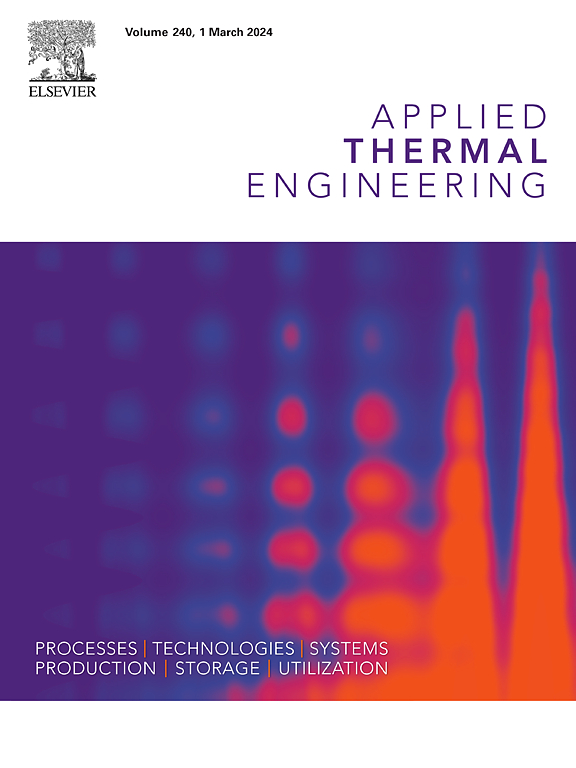Heat transfer enhancement in vehicle cabin heating system with hybrid nanofluid: An experimental and artificial intelligence approach
IF 6.1
2区 工程技术
Q2 ENERGY & FUELS
引用次数: 0
Abstract
In louvered fin-and-flat-tube aluminum heat exchangers, the interrupted surfaces of the louvered fin channel, through which air flows, enhance heat transfer by growing and degrading laminar boundary layers, while the large surface-to-cross-section flow area ratio of the flat tube further enhances heat transfer. Consequently, due to their relatively good heat transfer performance and compact design, louvered fin-and-flat-tube aluminum heat exchangers are often utilized for cabin heating systems. Considering previous studies involving louvered fin-and-flat-tube aluminum heat exchangers with conventional fluids and with mono-nanofluids, this is the first study employing Al2O3-TiO2/water hybrid nanofluid experimentally in this context, and utilizing a forward-looking ANN forecasting model for scenarios that cannot be experimentally conducted in such systems. Accordingly, the heat transfer enhancement in the louvered fin-and-flat-tube heat exchanger is experimentally investigated for both pure water alone and for different volume concentrations of Al2O3-TiO2/water hybrid nanofluid. Heat transfer rate, convection heat transfer coefficient, Nusselt number, effectiveness, overall heat transfer coefficient, pressure drop, and performance evaluation index were assessed for different inlet temperatures (50 °C, 60 °C, 70 °C) and volume flow rates (3.65 LPM, 5.65 LPM, 7.65 LPM) in the range 0–0.2 % volume concentration. The experimental results show that the highest heat transfer rate enhancement was 113.32 % using the hybrid nanofluid at φ = 0.2 % compared to pure water at a 50 °C inlet temperature and 7.65 LPM flow rate. It was further shown that even using only the hybrid nanofluid, the effectiveness can be increased up to 0.422 at a constant fan speed without the need to enlarge the heat exchanger size, at a flow rate of 7.65 LPM and an inlet temperature of 70 °C. It has also been found that the maximum values of the performance evaluation index calculated according to two different formulas are 2.260 and 2.049 at φ = 0.2 %. In the following part of the study, heat transfer rate, effectiveness, and pressure drop values in the instances of 0.3 % and 0.4 % volume concentrations were forecast using an artificial neural network model trained with the Levenberg-Marquardt algorithm using experimental data. With the proposed artificial neural network model, the forecast heat transfer rates were as expected, while the expected trend could not be achieved in terms of the effectiveness and pressure drop predictions. The study ultimately found that the utilization of a Al2O3-TiO2/water hybrid nanofluid in cabin heating systems, even at a relatively low concentration value of 0.2 %, is capable of achieving very high heat transfer enhancement in exchange for only a very minor pressure drop.
用混合纳米流体增强汽车座舱加热系统的传热:实验和人工智能方法
在百叶窗翅片和平管式铝热交换器中,空气流经百叶窗翅片通道的间断表面,通过层流边界层的增长和退化来增强热传递,而平管大的表面与横截面流面积比则进一步增强了热传递。因此,由于其相对较好的传热性能和紧凑的设计,百叶窗翅片-扁管铝热交换器通常被用于机舱加热系统。考虑到以往涉及使用传统流体和单纳米流体的百叶鳍片扁管铝热交换器的研究,这是首次在此背景下使用 Al2O3-TiO2/ 水混合纳米流体进行实验研究,并利用前瞻性 ANN 预测模型对此类系统中无法进行实验的情况进行预测。因此,实验研究了纯水和不同体积浓度的 Al2O3-TiO2/ 水混合纳米流体在百叶鳍片扁管热交换器中的传热增强效果。在 0-0.2 % 的体积浓度范围内,针对不同的入口温度(50 °C、60 °C、70 °C)和体积流量(3.65 LPM、5.65 LPM、7.65 LPM)评估了传热速率、对流传热系数、努塞尔特数、有效性、总传热系数、压降和性能评估指数。实验结果表明,在 50 °C 入口温度和 7.65 LPM 流速条件下,φ = 0.2 % 的混合纳米流体与纯水相比,传热率提高了 113.32%。研究进一步表明,即使只使用混合纳米流体,在流量为 7.65 LPM、入口温度为 70 °C、风扇转速恒定的情况下,效率也可提高到 0.422,而无需扩大热交换器的尺寸。研究还发现,在 φ = 0.2 % 时,根据两种不同公式计算得出的性能评估指数最大值分别为 2.260 和 2.049。在接下来的研究中,采用 Levenberg-Marquardt 算法训练的人工神经网络模型利用实验数据预测了体积浓度为 0.3 % 和 0.4 % 时的传热率、效率和压降值。利用所提出的人工神经网络模型,预测的传热率符合预期,而在有效性和压降预测方面则无法达到预期趋势。研究最终发现,在客舱加热系统中使用 Al2O3-TiO2/ 水混合纳米流体,即使浓度值相对较低,仅为 0.2%,也能实现非常高的传热增强,而换来的压降却非常小。
本文章由计算机程序翻译,如有差异,请以英文原文为准。
求助全文
约1分钟内获得全文
求助全文
来源期刊

Applied Thermal Engineering
工程技术-工程:机械
CiteScore
11.30
自引率
15.60%
发文量
1474
审稿时长
57 days
期刊介绍:
Applied Thermal Engineering disseminates novel research related to the design, development and demonstration of components, devices, equipment, technologies and systems involving thermal processes for the production, storage, utilization and conservation of energy, with a focus on engineering application.
The journal publishes high-quality and high-impact Original Research Articles, Review Articles, Short Communications and Letters to the Editor on cutting-edge innovations in research, and recent advances or issues of interest to the thermal engineering community.
 求助内容:
求助内容: 应助结果提醒方式:
应助结果提醒方式:


